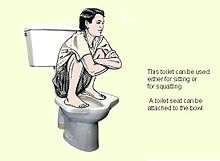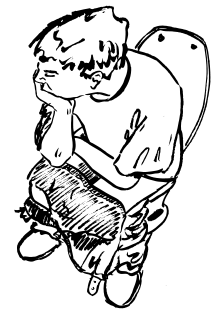- Human defecation postures
-
 Flush toilets are meant to be used with the user comfortably seated on them, but some medical researchers claim that this posture is associated with health risks
Flush toilets are meant to be used with the user comfortably seated on them, but some medical researchers claim that this posture is associated with health risks
Humans can perform defecation in a number of defecation postures. The two most common are the squatting defecation posture and the sitting defecation posture. The squatting posture is used for squat toilets. It is also commonly used for defecation in the absence of toilets or other devices. The sitting defecation posture is used in Western toilets, with a lean-forward posture or a 90-degrees posture. In general, the posture chosen is largely a culture decision.
The type of defecation posture chosen by an individual may affect certain medical conditions, such as defecation syncope (fainting while defecating). The posture used while using the toilet may also affect urination.[1]
Contents
Anorectal angle
Some authors believe that the anorectal angle (ARA), the angle formed by the junction of the rectum with the anus, is "one of the most important contributions to anal continence"; its normal value at rest is 90 degrees.[2]
According to a 1996 article in the Townsend Letter for Doctors and Patients,
In a classic paper, Tagart (1966) measured the anorectal angle in various postures, finding that the angle is partially straightened out when squatting. He argued that squatting thereby reduced the pressure required for defecation and recommended a hips-flexed position for defecation to help treat constipation and prevent haemorrhoids.[3]
In persons with anismus the anorectal angle during attempted defecation typically is abnormal.[4][5][6] This is due to abnormal movement of the puborectalis muscle, a hallmark of anismus.
Sitting defecation posture
The sitting defecation posture involves sitting with hips and knees at approximately right angles, as on a chair. Most Western-style flush toilets are designed to be used with a sitting posture.[7] The sitting posture is more widespread in the Western world, and less common in the developing world. Toilet seats are a recent development, only coming into widespread use in the nineteenth century.[8]
Advantages and health benefits
The sitting position helps protect privacy and leaves little or no chance of getting fecal matter on clothes or ankles. It may feel more comfortable as it can minimize strain in thighs, calves, ankles and lower back[citation needed].
Disadvantages and health risks
The sitting position causes the defecating human to assume a narrow anorectal angle, which some people believe is obstructive and causes difficulty in emptying the bowels. Critics of this posture say that squatting is "the only natural defecation posture".[9]
The sitting position can cause the defecating human being to repeat the Valsalva Maneuver many times and with great force, which may overload the cardiovascular system and cause defecation syncope. Sikirov also published 2004 study in which he compared the length of time needed to defecate using various postures, and concluded that the sitting defecation posture requires "excessive expulsive effort compared to the squatting posture."[10]
Squatting defecation posture
 Some toilets allow the user to defecate in either the squatting or the sitting position
Some toilets allow the user to defecate in either the squatting or the sitting position
The squatting defecation posture involves squatting by standing with knees and hips sharply bent and the buttocks suspended near the ground. Squat toilets are designed to facilitate this posture. It is more widespread in the developing world than in the Western world. In the US, the squatting position is colloquially known as the "Catcher's Position" or the "Catcher's Posture" because of its similarity to the posture that baseball players must maintain while playing the catcher position. The term "Catcher's Position" has been widely credited to Dr. M. K. Rizk, a US physician and researcher in the field of modern gastroenterology, and major proponent of the squatting defecation posture.
Advantages and health benefits
Denis Burkitt conjectured that the squatting defecating posture can prevent cancer, especially colorectal cancer.[11]
The anorectal angle that results from squatting allows smooth bowel elimination.[9] The squatting defecation posture requires less expulsive effort when compared to the sitting defecation posture[10] Dov Sikirov says that the squatting position could prevent the risk of defecation syncope and death due to cardiovascular complications associated (in Sikirov's research) with the sitting position, as squatting requires less amount of straining on part of the defecating individual.[7]
Squatting can be beneficial for patients suffering from the spastic pelvic floor syndrome, due to the increased anorectal angle enabled by the posture.[12]
A sitting posture may increase diverticulosis of the colon. The magnitude of straining during defecation is at least three times greater than with the squatting posture.[13]
Disadvantages and health risks
A team of Indian medical professionals did a study as to whether strokes were more likely to happen when defecating due to the squatting position. Their finding was the squatting defecation posture may place individuals at risk of stroke.[14] However, the study did not compare squatting with sitting for defecation, and did not measure the blood pressure of subjects using a sitting toilet.
Half of Indian men (who regularly use the squatting posture) have a high pressure zone in the rectosigmoid colon, which might be caused by diet or defecation posture.[15]
Defecation postures in space
See also: Space toiletRelated to work on a zero gravity toilet for use in the space station, there is no evidence that posture affects the ease of urination. Since defecation involves the stomach muscles, however, the body should be positioned to support them.
See also
- Defecography
- Human positions
References
- ^ A. Rane; A. Corstiaans (2008, Department of Urogynaecology, Townsville Hospital, Townsville, Queensland, Australia): Does micturition improve in the squatting position? in Journal of Obstetrics and Gynaecology, Volume 28, Issue 3 of April 2008, pages 317 - 319. Quotes: "Posture on the toilet is an important consideration during micturition", "the ability to squat in our population of volunteers was quite poor" (from the abstract).
- ^ ALTOMARE Donato F.; RINALDI Marcella; VEGLIA Antonella; GUGLIELMI Altomarino; SALLUSTIO Pier Luca; TRIPOLI Gaetano (Department of Emergency and Organ Transplantation, General Surgery and Liver Transplantation Units, Coloproctology Unit, University School of Medicine, Bari, ITALY) (2001): Contribution of posture to the maintenance of anal continence, in International journal of colorectal disease, 2001, vol. 16, number 1, pp. 51-54 (4 ref.). Publisher: Springer.
- ^ Christine Dimmer, Brian Martin, Noeline Reeves and Frances Sullivan , "Squatting for the Prevention of Hemorrhoids?", Published in Townsend Letter for Doctors & Patients, 1996: 159, 66-70 link
- ^ PMID 19681980
- ^ PMID 17410575
- ^ PMID 17223941
- ^ a b Sikirov, Dov, MD (1990): "Cardio-vascular events at defecation: are they unavoidable?" Medical Hypotheses, 1990, Jul; 32(3): 231-3.
- ^ A History of Technology, Vol.IV: The Industrial Revolution, 1750-1850. (C. Singer, E Holmyard, A Hall, T. Williams eds) Oxford Clarendon Press, pps. 507-508, 1958
- ^ a b Sikirov, Dov. (1989) Primary constipation: an underlying mechanism. Medical Hypotheses Feb; 28(2):71-3. PMID 2927355.
- ^ a b [1]
- ^ Burkitt, Denis (1979): "Don't Forget Fibre in Your Diet"
- ^ Cho YK, Kim CS, Koo ES, Yun JW, Kim JW, Lee JH, Park CY, Sohn CI, Jeon WK, Kim BI, Choi DI (2003): Contribution of Posture to Anorectal Angle and Perineal Descent on Defecography in Korean J Gastroenterol, 2003 Mar; 41(3):190-195 (in Korean). Quote: "In patients with spastic pelvic floor syndrome, squatting position increases the anorectal angle" (from the abstract).
- ^ Sikirov, B., A. (1988): Etiology and pathogenesis of diverticulosis coli: a new approach. Medical Hypotheses. May; 26(1): 17-20.
- ^ [2]
- ^ Rajkumar P. Wadhwa, Fersosh P. Mistry, Shobna J. Bhatia, and Philip Abraham (1994): Existence of a high pressure zone at the rectosigmoid junction in normal Indian men: "The role of diet or defecation posture in its etiology and its effect on bowel habit need to be studied."
Bibliography
- Balukian, L. (2002): In praise of squatting in Altern-Ther-Health-Med, 2002 Jan-Feb; 8(1): 26
- http://www3.interscience.wiley.com/journal/68502379/abstract?CRETRY=1&SRETRY=0
Categories:- Human body positions
- Toilets
Wikimedia Foundation. 2010.

